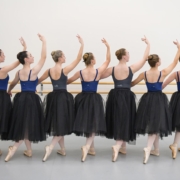How To Make a Ballet Bun: A Step By Step Guide with Redland Dance
Ballet buns are a classic hairstyle for ballet dancers, but they can be tricky to get right. However, with the right tools and a bit of know-how, they can be a breeze! In this how-to video, Miss Rebecca goes into detail and show you the exact steps for how to make a ballet bun and get it right the first time.
Things You’ll Need For a Ballet Bun
- A hairbrush with good bristles: A good bristle brush is essential to get your ponytail smooth and flat. A brush from Lady Jane is a great option.
- A tail comb: This will help you create a neat and tidy ponytail, and separate the hair into sections.
- Water in a spray bottle: Spraying your hair with water will help make it easier to work with and style.
- Strong hair gel: A good hair gel is key to keeping your hair in place and preventing flyaways.
- Hairspray: This will help to secure the bun in place and ensure that it lasts all day. Choose a hairspray with an extreme hold.
- Elastic for the ponytail: A strong ponytail elastic is crucial to support the weight of the hair. The ones from Woolworth’s are a good choice.
- Pins for the bun: To secure the bun in place, you’ll need the right kind of hairpin. Look for ones with a little ball at the end to avoid scratching your head. Hairpins from Cosmetics Plus are a good option, and come in black or brown.
- Hair nets: Some people prefer bun nets, which are slightly smaller, but personally, hair nets are a better choice as they can be wrapped around more. Choose a colour that is close to your child’s hair colour. In this video, we chose one from Price Attack which came in a pack of two.
How To Make a Ballet Bun Step by Step
- Wet the hair down: Give your hair a quick spritz of water and brush through with your hairbrush.
- Apply gel: Put a good dollop of gel into your hand and spread it evenly throughout the hair.
- Brush the hair into a ponytail: Use your tail comb to create a neat and tidy ponytail at the crown of the head.
- Secure the ponytail with an elastic: Make sure the elastic is tight enough to support the weight of the hair, but not so tight that it hurts.
- Loosely wrap the hair around: Take the hair from the ponytail and wrap it around in a circular motion, just like a snail’s shell.
- Secure with hairpins: Use the hairpins to secure the hair in place, pushing them in and tucking them under the bun. You can also use your tail comb to smooth down any bumps or flyaways.
- Add the hair net: Place the hair net over the bun and wrap it around a couple of times to get the tightness you want.
- Secure with hairspray: Give the bun a quick spritz of hairspray to set it in place.
- Add any hair accessories: If desired, you can add a hair accessory, such as a hairband or bow, to complete the look.
The Doughnut Bun
A doughnut bun is a popular hairstyle for dancers, especially for jazz performances. It creates a sleek and neat look that enhances the lines of the dancer’s neck and head. Here are the steps to create a doughnut bun:
- Start with clean, dry hair that has been brushed and detangled. Divide your hair into two sections: the top section of the hair and the bottom section of the hair.
- Take the top section of your hair and smooth it back, securing it with a hair elastic. Make sure to secure it tightly so it doesn’t come loose during your performance.
- Take the bottom section of your hair and twist it into a rope, starting from the ends and working your way up towards the roots.
- Wrap the twisted hair around the hair elastic that is holding the top section of your hair. Make sure to tuck the ends of the twisted hair underneath the bun.
- To secure the bun, insert bobby pins around the edges, making sure to place them parallel to the head. The bobby pins should be inserted through the bun and into the head, securing the bun in place.
- To create a smooth, polished look, use a hairnet or hair bun cover over the bun and secure it with bobby pins.
- Finish the look with hairspray to hold the bun in place and eliminate flyaways.
Remember, for a classical ballet bun, a doughnut is not necessary. It may be useful for tap and jazz pieces, but for classical ballet, it is best to leave the bun without a doughnut.
So there you have it, a simple and comprehensive guide to doing a ballet bun! With the right tools and a bit of practice, you’ll have a beautiful ballet bun in no time!
Enjoy a FREE Dance Class at Redland Dance!
Claim your free pass for a class at The Redlands' Premiere Dance School!

 Redland Dance
Redland Dance
 Redland Dance
Redland Dance James Morgan
James Morgan
 Redland Dance
Redland Dance